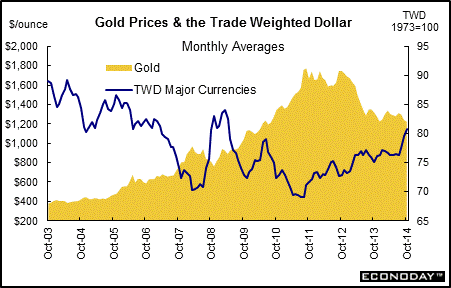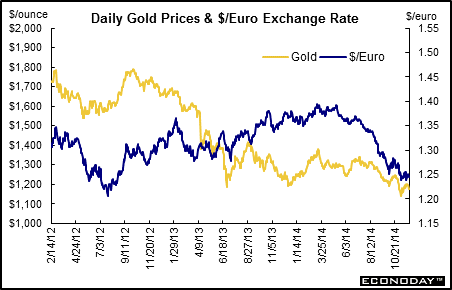
|
Long Term Perspective Gold is a special metal. It has long been considered a hedge against inflation even though it has not always kept up with inflation. Gold is also considered a safe-haven investment in times of uncertainty such as war, economic, financial and political turmoil. Yet, in recent years, more than one central bank announced its intention to sell some of its gold reserves. Could gold be losing some of its luster? Also, many investors are now viewing oil as an inflation hedge, somewhat softening the demand for gold.
Despite all its attributes, some Fed officials still consider this a primary indicator of inflationary pressures. However, if gold prices rise because of political turmoil, this doesn't mean that inflation is around the corner. Thus, it is very important to consider all factors that can cause gold prices to fluctuate. In the past ten years, one can make the case that gold prices fluctuated with the dollar exchange rate. Indeed, notice that gold prices fell when the trade weighted dollar increased, and conversely gold prices rose when the trade weighted dollar fell.
Actually, a declining dollar can indeed be inflationary because prices of foreign-produced goods become more expensive to U.S. consumers and businesses. By looking at gold prices in combination with other key indicators one can more readily interpret the reason behind the gold price fluctuations.
During 2009 through 2011, gold rose significantly on renewed concerns over rising federal deficits, potential default on sovereign debt by Portugal, Ireland, Greece, and Spain; and briefly over civil unrest in North Africa and the Middle East. Gold hit a recent high of $1,897.70 for a settle on August 22, 2011 (COMEX quotes). Slower economic growth and lessened inflation risk tugged down on gold in 2013 and 2014.
The dollar slipped in mid-2009 on fears of rising inflation and in late 2009 over concern over a ballooning federal deficit. But the dollar gained during early 2010 over concern about bank loan losses in Europe and a slowing in recovery there. However, the dollar softened in late 2010 and early 2011 as worries over European sovereign debt eased. But the dollar rebounded in 2012 and into late 2014 as the U.S. recovery gained traction and Europe weakened.
Short Term Perspective Flight to safety over European sovereign debt helped the dollar improve in mid-2011 and in 2012. Relatively stronger growth in the U.S. during late 2012 and early 2013 into 2014 also supported the dollar. As of November, 2014, the gold settle was $1,175.50.
A stronger dollar improves the outlook for lower inflation. When investors believe that the Fed will raise rates or overseas central banks will cut rates, the dollar appreciates. When investors believe that the Fed is done raising rates or foreign central banks will raise rates, the dollar declines in the FX market.
|
|||||||
| Legal Notices | ©Copyright 1998-2025 Econoday, Inc. |
powered by
![[Econoday]](images/logo.gif)
![[Apple App Store]](/images/AppleAppStore.png) ![[Econoday on Kindle]](/images/kindle.jpg) 
|
||||||

